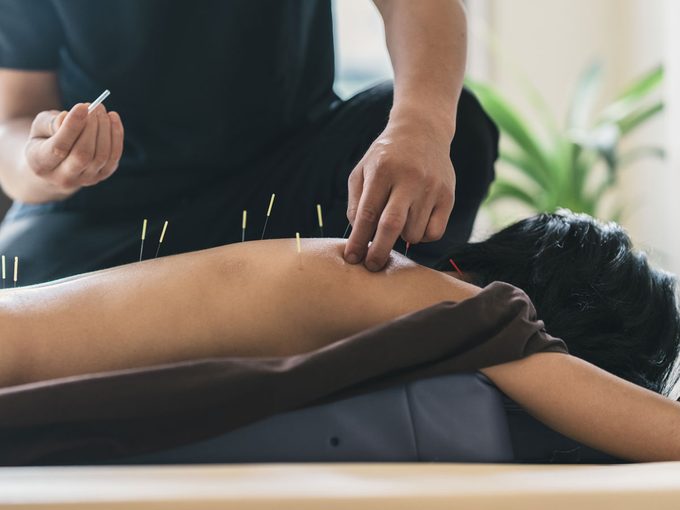5 Ways Acupuncture Can Help Improve Your Fitness
Acupuncture is widely used in North America to treat a range of ailments. Turns out, it can also help boost your exercise routine.

#1: Acupuncture treats muscle and joint pain
Judy Davies, an interior designer in Toronto, couldn’t lift her arm above her shoulder six years ago. Now she has full range of motion, she works out with a trainer and loves to cycle. “It’s like a miracle. I feel physically great all the time,” she says, “I’m ripped.”
The “frozen shoulder” problem was the result of a childhood injury where her shoulder was wrenched out of place, and it became worse over time. (Here’s more advice on how to deal with frozen shoulder pain.) “I could have had surgery, which would have been painful and might have corrected the problem, but I wanted to try another route,” Davies says. She began a program of fitness training, massage therapy, chiropractic treatment and acupuncture for muscle release, where ultra-fine needles from 3 to 5 cm in length are inserted into trigger points across the body. She started with several acupuncture treatments a month and now has a session about three times a year or as needed. “Nobody likes needles, but they don’t hurt at all. It’s very relaxing,” she says. “Acupuncture does work, especially in combination with everything else.”
How does it work? Acupuncture is a natural method to get to the root of the injury in the body by reducing inflammation locally, resetting neural pathways to decrease pain, and promoting re-oxygenation of the tissues, says Katie Au, an acupuncture practitioner, chiropractor and personal fitness trainer.
“Inserting needles into anatomical locations creates a very small injury, which your body must quickly heal. This stimulates healing of the surrounding tissues, including muscle, fascia, nerves, skin and connective tissue,” Au says. The healing reaction increases local blood supply and oxygen, and releases feel-good endorphins that act in the central nervous system to relieve pain. For more of an insight, here’s what it’s like to have acupuncture.
#2: Acupuncture for muscle release
Working out can be a pain — literally. Challenging your body with cardio and resistance training can strain and tighten your muscles, making you feel stiff and sore. And it’s not just exercise that can give you aches and pains — repetitive strain injury from typing on a keyboard or postural imbalances from prolonged slouching at a computer desk can also lead to muscle discomfort and restricted motion.
Acupuncture treats painful adhesions where scar tissue has formed in your muscles, ligaments and surrounding tissue, Au says. Your circulation gets a boost, endorphins decrease pain and muscles relax, resulting in improved range of motion, function and performance.
Positive results usually begin following the first acupuncture treatment, where muscles feel relaxed and movement tends to be less effortful and restricted. However, there may be some local muscle soreness for 24 to 48 hours.
#3: Acupuncture speeds up recovery of sports injuries
“Tennis elbow” and hamstring strain in a long distance runner are common sports injuries treated by acupuncture. Before chiropractic college and acupuncture certification, Au was a competitive diver and would turn to acupuncture for muscle strain to stay in top form.
Simple rest and relaxation will help you recoup from injury, but acupuncture will improve and speed the body’s natural healing ability, she says. Low and high-frequency electrical stimulation often is applied to some or all of the needles to further boost treatment benefits.
#4: Acupuncture improves the results of training programs
Au recommends having an acupuncture treatment right after a workout or other type of physical activity to promote your body’s natural ability to recover. “If individuals can enhance their recovery process, they’re able to push themselves harder each and every time,” she says. “The harder you push yourself and increase your intensity, the more calories you burn and the more you physiologically change your body to new levels.”
One of Au’s patients had acute knee pain following a weekend with golfing and jogging. Post acupuncture treatment, he was pain-free and immediately able to return to his regular daily activities, including jogging. He’s combined training with acupuncture for muscle release on a regular basis, changing his sedentary lifestyle to one that includes weight-training and cardio exercises every week.
#5: Acupuncture boosts psychological well-being
“The needle point on the top of the head is known as GV-20 (Governing Vessel 20),” Au says. Many people call this point a “happy point,” so it’s a common location for acupuncture needle application. There are multiple other acupuncture points throughout the body that promote psychological well-being, feelings of calm and restoration, and reduce anxiety and stress.
A sense of wellbeing may also be attributed to other effects of acupuncture — a more balanced nervous system, decreased blood pressure, stress relief, reduced mental fatigue and improved sleep — all good things to help you improve your fitness. Next, read up on 5 safe exercise strategies to help reduce your risk of injury.




